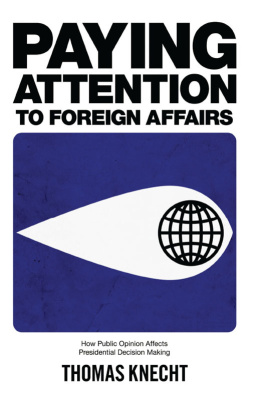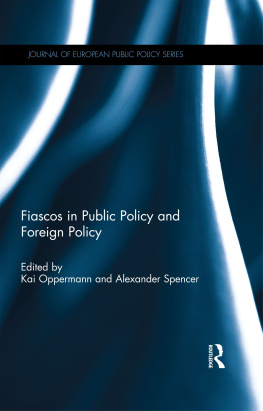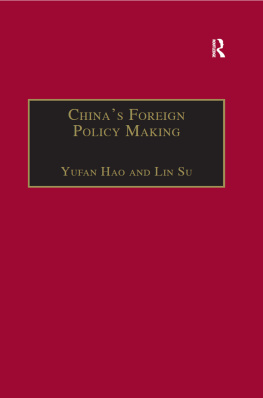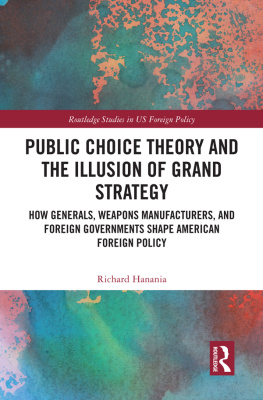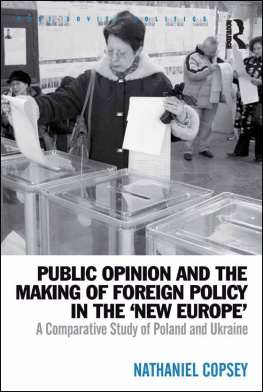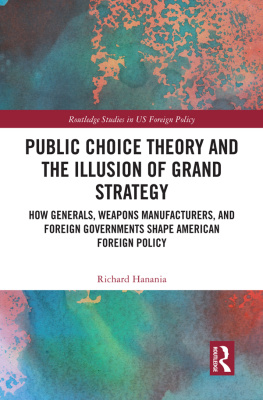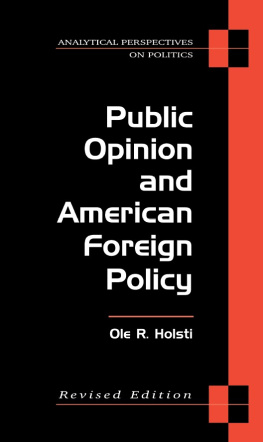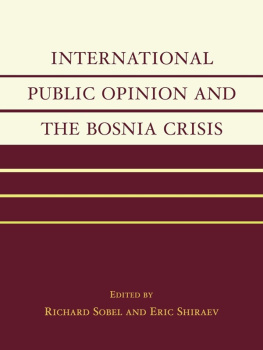Library of Congress
Cataloging-in-Publication Data
Knecht, Thomas, 1971
Paying attention to foreign affairs : how public opinion affects presidential decision making / Thomas Knecht.
p. cm.
Includes bibliographical references and index.
Summary: Examines the relationship between public opinion and U.S. foreign policy. Argues that policy making under intense public scrutiny differs from policy making when no one is lookingProvided by publisher.
ISBN 978-0-271-03753-0 (cloth : alk. paper)
1. United StatesForeign relationsDecision making.
2. Public opinionUnited States.
I. Title. JZ1480.K58 2010
327.73dc22 2010020744
Copyright 2010
The Pennsylvania State University
All rights reserved
Printed in the United States of America
Published by
The Pennsylvania State University Press,
University Park, PA 16802-1003
The Pennsylvania State University Press
is a member of the
Association of American University Presses.
It is the policy of The Pennsylvania State University Press to use acid-free paper. Publications on uncoated stock satisfy the minimum requirements of American National Standard for Information SciencesPermanence of Paper for Printed Library Material, ANSI z39.481992.
This book is printed on Natures Natural, which contains 50% post-consumer waste.
In a democracy, it is generally assumed that citizen preferences inform public policy. But do American presidents really consider public opinion when making foreign policy decisions? For a variety of reasons, foreign policy has always posed a difficult challenge for democratic governance. Citizen oversight of public officials requires an active and informed electorate, yet the American public is only sporadically attentive to and knowledgeable about foreign affairs. Additionally, citizens foreign policy preferences sometimes conflict with the policies that presidents believe to be in the national interest, forcing the White House into a difficult choice between political expediency and strategic effectiveness. Further complicating matters are national security concerns that prevent a full disclosure of information to the public. These and other challenges have been especially apparent in recent history. The U.S. intervention in Kosovo, the Kyoto Protocol, and the Iraq War have led some observers to question what role, if any, the public plays in the construction of American foreign policy.
This book examines whether presidents lead, follow, or simply ignore the American public when making foreign policy decisions. Our exploration into the publics role in U.S. foreign policy departs from a rather unusual place: a personal story that has nothing to do with international affairs. About a year ago, I was at home playing with my kids when the phone rangit was a local survey organization wanting to hear my opinion of the new hospital being built in my community. Fortunately, ours is a relatively healthy family, and I only think of hospitals when one of our kids breaks a leg (or when a pollster asks me questions about hospitals). But being a college professor in the field of American public opinion, I believe it is important to respond to surveys, even those concerning topics I have little interest in or knowledge of. I agreed to be interviewed, so the pollster asked what kind of services I thought the local hospital should provide: Should it have an eye institute? Should the emergency room staff include a pediatric specialist? Should the hospital perform hip and knee replacements? Should it have a cosmetic surgery wing? I replied to all of these queries with an emphatic yes! After all, I wanted the best hospital money could buy just in case, God forbid, a member of my family should ever need it. I hung up the phone and did not think about hospitals again until my daughter had a high-grade fever seven months later.
This anecdote may seem a bit off topic, but it does offer several insights about the nature of public opinion in general that we will relate to the specific issue of public opinion and foreign policy. First, it is easy to offer an opinion to pollsters. I had given no thought to our new hospital before the survey call, so when answering the questions, I paid little mind to the problems that hospital administrators surely deal with, such as budgets, staff, and space. My responses, although genuine, were probably a bit poorly considered, but I offered them anyway. Second, just because a clear and definitive opinion is expressed in a survey does not mean that the issue is important to the respondent. Again, I rarely had thought of hospitals, so I was not going to base my vote in the upcoming election on a candidates hospital platform, and I was not planning on marching in the streets to demand a cosmetic surgery wing. The issue was simply not that important to me at the time, but again, that lack of salience didnt stop me from staking a clear and definitive position when asked for my opinion. Third, the importance of an issue can change over time. While hospital services were not that salient to me at the time of the survey, they suddenly became very important when my daughter became ill. (Her illness turned out to be minor, but we did have to drive twenty miles to the next hospital because ours did not staff the appropriate pediatric specialist.)
The final and most important lesson is that the interaction of preferences and issue salience prompts both citizen action and government response. Even though my preferences for hospital services had not shifted one little bit in the seven months after the survey call, the salience of those very same opinions increased dramatically when my daughter became ill. The confluence of strong preferences and high issue salience eventually prompted me to become more active toward our local hospital (I consider active to be writing a letter of complaint about the lack of pediatric specialists on staff), something I would not have done if my child had stayed healthy or if I were ambivalent about which services were important for the hospital to have. On the other side of the ledger, I expect that a hospital administrator comes under the greatest pressure to respond to citizen demands when a significant majority of the public holds similar opinions and is highly attentive to local health care. On that score, my one little letter demanding that a pediatric infectious disease specialist be on the hospitals payroll was probably insufficient to produce any real change.
This book takes lessons about public opinion drawn from the hospital story and applies them to U.S. foreign policy; but instead of looking at opinion from the perspective of the respondent, we examine what the situation looks like from inside the Oval Office. While presidents may be able to ignore the public when Americans are divided on the issues or are inattentive to what is going on, it is politically dangerous to snub a large majority of people who care deeply about an issue. And if presidents are indeed most sensitive to public opinion when a large majority of Americans hold the same preference and the issue is highly salient, then the obvious question arises: can we forecast when that convergence will occur? The evidence provided in this book suggests that we can. The American people tend to be a predictable lot when it comes to foreign policy. The public is generally interested in some aspects of foreign policy while giving a collective yawn to others. Likewise, the public tends to unify around some foreign policy options, only to divide on others. This movement of public opinion and attention is not random but rather conforms to predictable patterns. By tracing these patterns, we can forecast when presidents are likely to lead, follow, or ignore the public.

